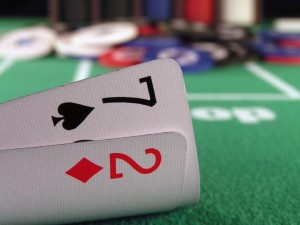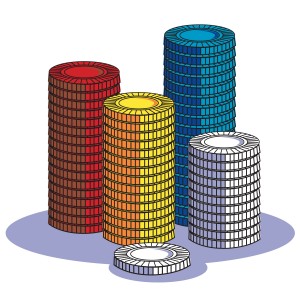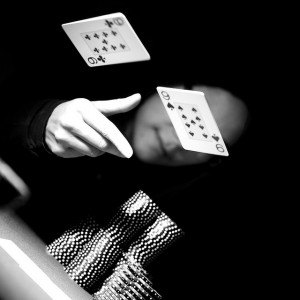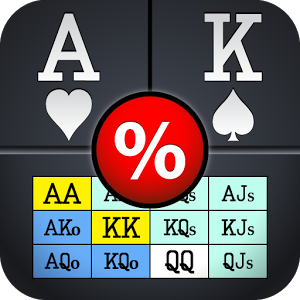Bluffing in limit hold’em is an interesting science. In loose games it is usually inadvisable to bluff because your opponents will call down with very marginal holdings. However, today’s games are not as loose as they used to be, especially at the mid/high limits.
If you play in the tougher limit games of today, then bluffing is something that you almost need to have in your arsenal. Not only does it stop you becoming predictable to observant opponents, but more importantly it helps you to pick up some key pots that would otherwise have slipped away. Also in tougher games, pots are more likely to be fought heads-up, which is by far the best situation in which to bluff.
A good bluff is one that has long-term positive expectation. In other words, if the value of the pot multiplied by the odds of the bluff working is greater than the cost of the bluff. Obviously this is slightly crude and doesn’t take into account things like your opponent calling but then you backing into a winner, but generally speaking this is how you should evaluate your bluffs. Finding bluffs that have positive expectation can be tricky and it is difficult to evaluate your decision without being results orientated. Just because your bluff failed in this particular instance doesn’t mean it was a bad bluff. In fact, because of the nature of limit holdem, your bluffs will fail more often than not, but the times when they succeed can be a major coup.
In this article we will look at five situations where bluffing can have huge equity. Where the bluff succeeds significantly more often than you need to break even. While bluffing can be a very imprecise science, in the situations described below you can usually make the bluff with confidence, knowing that it will make you money in the long run.
1. Unwanted blinds steal
You are in the big blind. Everybody folds to the small blind who calls and you check. The small blind checks the flop.
You should bet. Note I haven’t even mentioned any cards yet, because they are largely irrelevant. Even if you hold 7s 2c on a flop of Ad Kd Qd you should usually bet here. Your opponent has shown a huge amount of weakness, firstly by not raising pre-flop and then not betting the flop. Chances are they have a very weak hand and will fold when you bet. They only actually need to fold 1 time in 3 for this bluff to show immediate profit and experience shows most players will fold far more often than that.
It doesn’t really matter which type of player you are up against (although good players will rarely put themselves in this situation to start with). Even if you are against a very loose player who will call more than 2/3 of the time then you are usually better off betting. You can then see the turn and probably take a free river if you require or bet again if you hit or think a second barrel bluff will have positive expectation.
You can also make this play out of position against a lone limper. Obviously there is more chance your opponent has a hand as they haven’t yet had the chance to act on the flop. However, you still only need them to fold a third of the time and your bluff looks more believable so you may get a fold from hands like a weak bottom pair.
2. Scare card bluff
The idea of bluffing a scare card is hardly new, but many players do it at the wrong time in a very transparent way. The trick to bluffing a scare card is to do it when your opponent already thinks that card hit your hand. For example, raising a flush card on the river may work once in a blue moon, but raising a flush card on the river when your opponent already thinks you have a flush draw is far more deadly.
Obviously this kind of bluff will only work if:
a)Your opponent is capable of laying down a hand (this applies to most bluffs obviously) and
b)He is thinking at the appropriate level that he will put you on the hand you are representing.
So you need to know a little bit about your opponent before you can make this play with confidence. If you are up against a thinking opponent who is capable of folding then here is an example of the scare card bluff in action.
You have Jc Tc and open raise from the cutoff, only the big blind calls. The flop is Ks 8d 5d, you bet and the big blind calls. The turn is the 3c; you decide to fire a second barrel and your opponent calls again. The river is the Ah and your opponent checks, you should bet. Your opponent hasn’t made any aggressive moves and it is likely that he isn’t too fond of his hand even before the river. He could be playing a lot of hands against your steal raise and most likely has an 8, 5, pocket pair or flush draw given the action so far. He may well be calling down in the hope that you have a big Ace that missed the board. If this is the case, when the ace hits on the river, he will be inwardly groaning. Even though you only have jack high and shouldn’t make a habit of 3-barrel bluffing, the scare card makes the bluff a smart play. Your opponent may have an ace himself, or make a crying call with a small pair, but will probably fold far more than the 1 in 6 times required to make the bluff profitable.
3. Turn semi-bluff
Once again, semi-bluffing in a heads-up pot is nothing new. In fact, in this day and age, most players will raise a flush draw or 8-out straight draw on the flop as a matter of course. A semi-bluff on the turn is more unusual because you have only one more card to hit your hand and so your pot equity is vastly diminished. However, this very fact makes it a potentially potent weapon because your opponent is less likely to put you on a flush draw when you raise. In reality it is more like a pure bluff than a semi-bluff, because most of the value of the play comes from your folding equity. Here is an example of a good semi-bluff turn raise:
You hold Th 8h in the big blind and call a raise from middle position. The flop is 7c 4h 2s and you call the continuation bet with your overcards and weak back-door draws. The turn is the Qh. You check and your opponent bets. Against a standard tight-aggressive opponent, you should consider raising here. If he folds more than 33% of the time you show instant profit. If he calls you have 9 good outs and maybe as many as 15. After all, there is no reason to assume your opponent has a pair here as a tight-aggressive player will often bet the turn regardless. Your raise may get hands like AT, 55 or even AK to fold.
Note that this bluff works best when there is a good chance that your opponent is continuation bluffing and the board is fairly dry (so your opponent is unlikely to hold a draw himself). Many opponents will peel the turn if they have something like an overcard and a gutshot, dulling the power of your bluff.
4. Dry flop bluff
A lot of players never bluff in multi-way pots and with good reason. But in some situations, a timely bluff at a small pot on the flop can show good profit. The classic example is when you are last to act and everybody has checked to you. In this case you can bluff hope to pick up the pot there and then, knowing that if you get called then you can probably take a free card on the turn if required. However, you can also make this play when not last to act and sometimes this gives you better folding equity against observant players, because it looks less like a bluff.
For example, let’s say you are in the big blind. A weak-tight late position player calls, the small blind completes and you check. The flop is A84 rainbow. If the small blind checks, then you should probably bet with anything. The small blind has already indicated he doesn’t like his hand, and the late position player probably hates the ace if he doesn’t have one himself. A lot of the time, considerably more than the 25% required, both of your opponents will fold if you bet here.
This play works best on dry flops where your opponents are unlikely to have any kind of draw. It is also possible to make this play when first to act (for example if you are in the small blind in the example above) or in a 4-handed pot. Obviously the conditions have to be more perfect for it to be profitable in these cases though.
5. Dead money bluff
A large pot can make it worth bluffing in some pretty low percentage situations. Many tight players don’t properly adapt to pot size and can be coaxed into incorrectly folding their hand when you show strength. This situation most often occurs when a pot is multi-way pre-flop, but one or more players fold later in the hand, leaving dead money in the pot. This can leave a situation where you are in a large pot, but with only one opponent making it a good spot for a bluff even if other conditions aren’t optimal.
For example, you hold 7h 7d in the cutoff. You raise, the small blind (a fairly tight unimaginative player) 3-bets, the big blind calls and you call. The flop is Ad Kh 6s. The small blind bets, the big blind folds. While a fold certainly isn’t a bad play here, a bluff raise can have good equity. While you are probably behind, you are risking 2 small bets to win 10, so your bluff only has to work 1 time in 6 to be profitable. If you assign the small blind’s range as AA-99 and AK-AJ (reasonable for a tight player re-raising from the SB), then this breaks down as follows:
AA – 3 combinations
KK – 3 combinations
QQ – 6 combinations
JJ – 6 combinations
TT – 6 combinations
99 – 6 combinations
AK – 9 combinations
AQ – 12 combinations
AJ – 12 combinations
In other words, there is a 24 in 63 chance (over a third) that your opponent hates their hand and will likely throw it away. Remember, your bluff is believable because you raised pre-flop and so could easily have top pair or better.
This kind of situation comes up more often than you would think in tight games. Another common example is when you call a raise from the big blind and the small blind comes along too. You miss the flop and check with the intention of folding. However, if the pre-flop raiser bets and the small blind folds, you can pick up a lot of pots with a raise, making it look like you were going for the check-raise all along. Obviously this play is dependant on the texture of the flop, the tendencies of the pre-flop raiser and your own table image.
Hopefully this article has got you thinking about bluffing and maybe you have identified areas where you can steal an extra pot or two and improve your win rate. At all but the lowest limits, the time where you can be a big winner by playing uninspired ABC poker is gone. While many players still bluff too much, some very good players use it as a powerful weapon.
Submit your review | |









